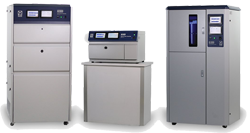耐候性試驗
Weathering Testing
咨詢熱線
18566398802ASTM D1499-2013
ASTM D1499-2013標準介紹
ASTM D1499 操縱塑料暴露用曝光和暴水裝置(碳弧型)的操作規程(塑料用濾光明火碳弧型曝光裝置的標準實施規程)
ASTM D1499-2013發行信息
標準號ASTM D1499-2013
中文名操縱塑料暴露用曝光和暴水裝置(碳弧型)的操作規程
英文名Standard Practice for Filtered Open-Flame Carbon-Arc Exposures of Plastics
發布日期2013
實施日期
廢止日期無
中國標準分類號G31
國際標準分類號83.080.01 (Plastics in general)
發布單位US-ASTM
ASTM D1499-2013適用范圍
4.1 The ability of a plastic material to resist deterioration of its electrical, mechanical, and optical properties caused by exposure to light, heat, and water can be very significant for many applications. This practice is intended to induce property changes associated with end-use conditions, including the effects of sunlight, moisture, and heat. The exposure used in this practice is not intended to simulate the deterioration caused by localized weather phenomena, such as, atmospheric pollution, biological attack, and saltwater exposure.
4.2 Cautionsx2014;Variation in results may be expected when operating conditions are varied within the accepted limits of this practice. Therefore, no reference to the use of this practice shall be made unless accompanied by a report prepared in accordance with Section 9 that describes the specific operating conditions used. Refer to Practice G151 for detailed information on the caveats applicable to use of results obtained in accordance with this practice.
Note 2 Additional information on sources of variability and on strategies for addressing variability in the design, execution, and data analysis of laboratory-accelerated exposure tests is found in Guide G141.
4.2.1 The spectral power distribution of light from an open-flame carbon-arc is significantly different from that produced in light and water exposure devices using other carbon-arc configurations or other light sources. The type and rate of degradation and the performance rankings produced by exposures to filtered open-flame carbon-arcs can be much different from those produced by exposures to other types of laboratory light sources.
4.2.2 Interlaboratory comparisons are valid only when all laboratories use the same type of carbon-arc, filters, and exposure conditions.
4.3 Reproducibility of test results between laboratories has been shown to be good when the stability of materials is evaluated in terms of performance ranking compared to other materials or to a control.5,6 Therefore, exposure of a similar material of known performance (a control) at the same time as the test materials is strongly recommended. It is recommended that at least three replicates of each material be exposed to allow for statistical evaluation of results.
4.4 Test results will depend upon the care that is taken to operate the equipment in accordance with Practice G152. Significant factors include regulation of line voltage, freedom from salt or other deposits from water, temperature and humidity control, and conditions of the electrodes.
1.1 This practice covers specific procedures and test conditions that are applicable for exposure of plastics in filtered op......
4.1塑料材料抵抗因暴露于光、熱和水而導致的電氣、機械和光學性能劣化的能力在許多應用中可能非常重要。本規程旨在引起與最終使用條件相關的性能變化,包括陽光、水分和熱量的影響。本規程中使用的暴露不是為了模擬局部天氣現象造成的惡化,如大氣污染、生物攻擊和鹽水暴露。
4.2;當操作條件在本規程的可接受范圍內變化時,可預期結果的變化。因此,除非附有根據第9節編制的報告,說明所用的具體操作條件,否則不得提及本規程的使用。參考規程G151,了解適用于使用根據本規程獲得的結果的注意事項的詳細信息。注2:關于可變性來源以及解決實驗室加速暴露試驗設計、執行和數據分析中可變性的策略的附加信息,見指南G141。
4.2.1明火碳弧產生的光的光譜功率分布與使用其他碳弧配置或其他光源的光和水暴露裝置產生的光譜功率分布明顯不同。暴露于過濾明火碳弧產生的退化類型和速率以及性能等級可能與暴露于其他類型的實驗室光源產生的退化類型和速率以及性能等級大不相同。
4.2.2只有當所有實驗室使用相同類型的碳弧、過濾器和暴露條件時,實驗室間比較才有效。
4.3當根據與其他材料或對照物相比的性能等級評估材料的穩定性時,實驗室間試驗結果的再現性已被證明是良好的。5,6因此,強烈建議在試驗材料的同時暴露具有已知性能的類似材料(對照物)。建議對每種材料至少進行三次重復,以便對結果進行統計評估。
4.4試驗結果將取決于按照規程G152操作設備時的謹慎程度。重要因素包括線路電壓調節、無鹽或其他水沉積物、溫度和濕度控制以及電極條件。
溫馨提醒:本ASTM D1499-2013可能存在更新的版本,建議尋找ASTM D1499-2013的發行商確認。

 粵公網安備 44060402000067號
粵公網安備 44060402000067號